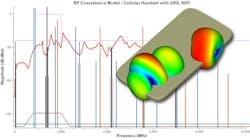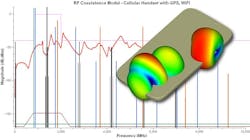Delcross upgrades Electromagnetic Interference Toolkit with new commercial radio system and digital noise signal definitions
CHAMPAIGN, Ill., 6 Aug. 2014. Delcross Technologies has released version 3.4 of its Electromagnetic Interference Toolkit (EMIT) software with 13 new pre-defined transceiver, receiver, and transmitter definitions for commercial radio systems, and the ability to define noise sources for receiver desense analysis applications.
EMIT is a software framework for cosite simulation and management of installed RF systems, including multiple receivers, transmitters, antennas, interconnection components, and installation platforms. EMIT manages installed RF system performance data, simulating intra-system RF EMI effects and mitigating EMI issues, that results in a comprehensive database/model maintainable over the life of a host platform.
EMIT release 3.4 introduces 13 new predefined commercial radio definitions to the EMIT system library, reducing the setup time for many cosite analyses. Radio definitions include both architectures, and programming: channel definitions, channel bandwidths, modulation type, noise levels, spectral profiles, power levels, MDS, intermodulation, harmonic and mixer products, frequency hopping definitions, and other key system parameters which influence the spectral behavior of RF systems.
The new radio definitions include GSM, LTE, UMTS, Bluetooth, 802.11 (WiFi), 802.11ad (WiGig), 802.16-2012 (WiMax), 802.15.4-2011 (ZigBee), GPS (L1/L2 bands), and GLONASS ( L1/L2) definitions. New cellular transceiver definitions provide both mobile and base station definitions. A total of 58 predefined radios are now packaged with EMIT, providing an integrated library of existing transceivers, receivers and transmitters.
In addition to new RF system definitions, EMIT V3.4 provides new digital noise sources suitable for use in Receiver Desense analysis to model unintentional radiators. The new noise waveform definitions include trapezoidal clock (rise/hold/fall) with duty cycle, pseudo random bit stream (PRBS), common-mode differential pair skew noise, and spread spectrum clock (SSC) signals.
Delcross is now providing EMIT Version 3.4 to customers. Current Delcross EMIT customers with a current software maintenance contract will receive this upgrade free of charge.

